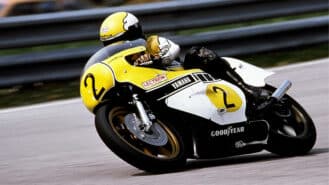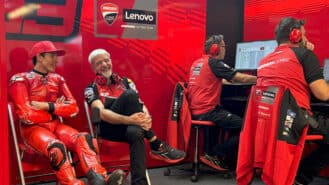In the MotoGP paddock at Silverstone this week there was a great deal of talk about cost-cutting, about the pros and cons of the new CRT bikes which have been introduced with cost-cutting in mind.
Costs are a hot topic in motor racing these days, as you might expect, given the widespread financial problems affecting the whole of Europe. Motor sport is, and always has been, an expensive activity and nowhere more so than in MotoGP and Formula 1 racing. MotoGP teams do not attract the level of sponsorship that we find in Formula 1, motorcycles have never been as appealing to blue chip global companies as the Grand Prix cars. If it were not for Honda and Yamaha, and Marlboro’s sponsorship of Ducati, cash would be extremely thin on the ground.
Wherever there is talk of cost-cutting there is politics, the two are inseparable, especially against the background of sovereign debt and bank bailouts. This may well explain why Ferrari president Luca di Montezemelo has joined the fray this week. Di Montezemelo is a politician, with ambitions in Italy, and he has a Spanish bank supporting his team at a time when Spanish banks are under extreme pressure. Money is tight in Italy too, so his timing is, as ever, unsurprising. Ferrari, after all, is one of the best-funded teams in F1 and yet its president has chosen this moment to raise the subject of costs.

MotoGP and F1 have, thus far, chosen to tackle the problem in different ways. The CRT bikes we see bulking up the MotoGP grid are cheaper to build, cheaper to lease and more economical to run, giving the promoter Dorna an opportunity to extend the life of a championship which is increasingly under financial pressure. In F1, the FIA has unilaterally decreed that, as from 2014, the cars will use six-cylinder turbocharged engines in an effort to both reduce costs and give the sport a ‘greener’ image. Not all the teams are happy with this move and a new Concorde Agreement between the teams and Mr Ecclestone has yet to be signed.
Intriguingly, Ferrari has expressed its support for the new formula, and along with Red Bull, has removed itself from FOTA, the teams’ organising body.
So why has di Montezemelo chosen this moment to call for further cost-cutting? You can never be sure with politicians, but maybe he has seen the writing on the wall concerning the Italian economy. Both Santander and Fiat are facing problems. “Ferrari agrees with the FIA that drastic intervention is required,” says di Montezemelo, “and the issues have to be tackled at the highest level without delay.” Of that there can be no doubt, bearing mind the state of the global economy, but how it is to be done within a sport that is populated by highly competitive people, many of whom have their own agendas?
Hopefully F1 will not follow MotoGP’s example with CRT. A Grand Prix grid must be exclusively for Grand Prix cars, not a hotchpotch of classes to make up the numbers. Moving to a new engine for 2014 will be expensive in itself and a better solution, surely, would be to retain the current formula but with far more tightly controlled budgeting. We are in an era of exciting, close-fought racing, so it would be a nonsense if that were to be thrown away.
Costs must be cut, everyone knows that, and motor racing should not be an exception to the austerity affecting the rest of Europe. But there are better ways than building new cars and new engines. That won’t work if Ferrari, Red Bull and McLaren are allowed to continue with budgets that the other nine teams can only dream about. Politics and money. We’ve been here before.





